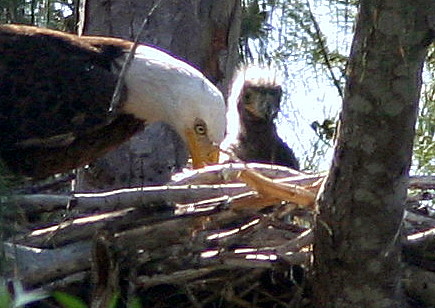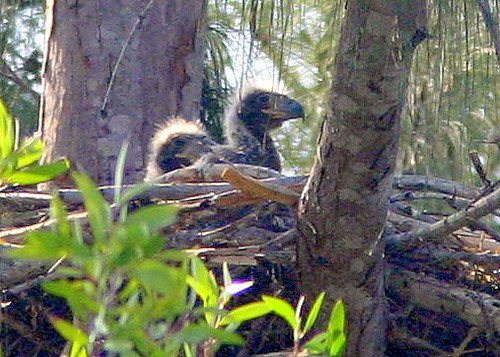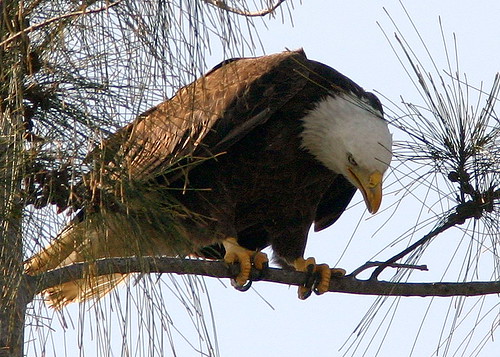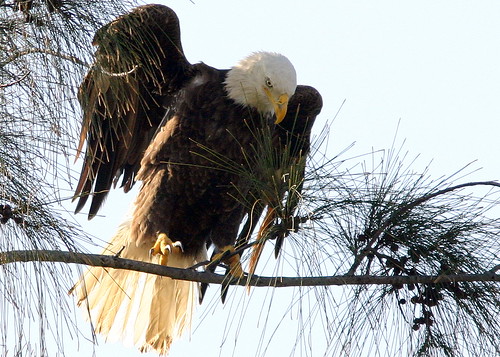The last time I photographed both of our local Bald Eagle chicks in the same frame was on February 8. I was a bit anxious that one may not have survived, as the older and stronger one sometimes pecked at the little one and flapped quite a bit, suggesting they were fighting. It is not uncommon for the first chick to starve out or even kill it nest mate, especially if food is scarce. This morning, I was happy to see two little fuzzy heads popping up above the rim of the nest. Food appeared to be plentiful, as prey was brought in twice during the 90 minutes I watched the nest.
The two chicks wait to be fed:
The oldest chick is 27 days old today, and the younger is about 5 days younger. The size difference is quite noticeable. On February 6, I first photographed the head of the older chick bobbing above the nest rim. It was able to hold its head up for extended periods and look around on February 8, though I could see the younger bird next to it through the nest material. Today, February 13, was the first day I photographed the younger chick with its head held high, though other eagle nest watchers saw it doing it yesterday. Thus, the smaller eaglet is about 5 days behind in its development, which supports our conclusion that the second egg was laid on December 18th, and probably hatched around January 22.
The older chick, after eating first, watches while the other is being fed:
One of the adult eagles displayed an interesting behavior this morning. It swooped down over a nearby pasture and came up with some vine-like greenery, which it brought to the nest and apparently left there. I had witnessed this once before, and other eagle watchers mentioned seeing the same thing happen. Then, after the eaglets had been fed, the adult that had been brooding them flew to and Australian Pine, one of the favored roost trees, and cleaned its bill. Then, it tore off a small twig and returned to the nest, presumably with the twig, then immediately left. I did not witness that the twig (or, earlier, the vine) was actually deposited on the nest.
This reminds me of the behavior of a pair of Northern Goshawks that I observed at their nests for several seasons in New Mexico. They brought in fresh green pine boughs all during the nesting period. Some were visible on the outside of the nest. Red-tailed Hawks are also known to do this, and I have heard that it is believed to repel parasitic insects.
The eagle examines a twig on its roosting perch:
Then, grasps the twig:
Finally, it breaks off the twig and flies away with it:
Arthur Cleveland Bent, in Life Histories of Familiar North American Birds, in his account of the Bald Eagle, wrote (1933): “Branches of pine and other green vegetation were always brought to the… nests both early and late in the season, and leaves were occasionally eaten by both adult and young eagles, as proved by their castings, but what significance this may have, if any, has not been ascertained.”
Bent also described (1937) similar activity in the case of the Golden Eagle: “Green grass, or green leaves, often attached to the twigs, are added from time to time, especially after the young are hatched.”
Robert Koppenhaver recorded the nesting activities of a pair of Bald Eagles along the Delaware River in the spring of 2006. His account is very detailed and makes interesting reading. Here is his description of similar behavior:
The Webmaster of the 2007 Eagle Cam Web Log, sponsored by the Friends of Blackwater National Wildlife Refuge in Cambridge, Maryland, includes this information and a hypothesis as to its purpose.
















